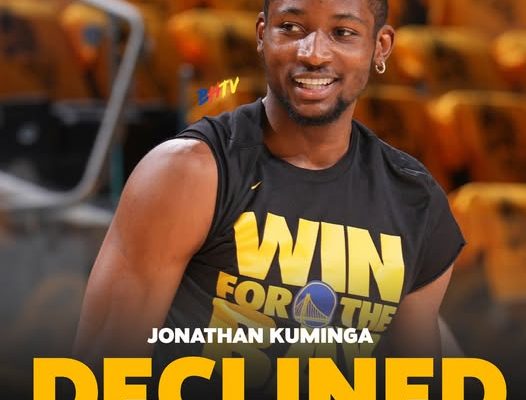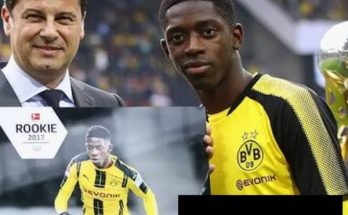BREAKING: Jonathan Kuminga Turns Down Warriors’ 2-Year, \$40 Million Deal Amidst Contract Tension and Franchise Uncertainty
Jonathan Kuminga has never been one to play by the script, and in an offseason buzzing with trade rumors, contract negotiations, and front office reshuffling, the 21-year-old forward made a bold move that might have ripple effects far beyond the Bay Area. Turning down a two-year, \$40 million contract extension from the Golden State Warriors isn’t just a financial decision—it’s a statement, and one that hints at deeper undercurrents within a franchise grappling with the twilight of its dynastic core and the pressures of rebuilding on the fly. For Kuminga, it’s a defining moment in a career that’s still unfolding but already packed with potential, frustration, flashes of brilliance, and, now, a decisive bet on himself.
The offer from Golden State was seen by many within league circles as both generous and cautious. On the one hand, a \$20 million annual salary for a player who has only recently begun to show starter-level consistency is far from a lowball offer. On the other hand, Kuminga’s late-season surge and postseason poise during the 2025 playoffs made it clear he could be on the brink of stardom. That dichotomy—between what he’s been and what he could become—may have played a key role in the negotiations. From Kuminga’s camp, the message is becoming unmistakable: he believes he’s more than just a rotational piece, more than just an athletic wing with upside. He believes he is a future star in the making, and he’s prepared to let the next season prove it.
Sources close to the situation suggest that the talks between Kuminga’s representatives and the Warriors began with optimism but soon unraveled over issues of role definition and financial respect. While the Warriors front office reportedly sees Kuminga as a major part of their future, that belief appears to be tethered to certain structural limits—limits that Kuminga no longer seems willing to accept. The Warriors’ \$40 million offer was based on what they believe is fair market value for a developing wing player still learning to harness his considerable gifts. But to Kuminga, that valuation failed to reflect what he believes he’s worth today and, more importantly, what he could be worth a year from now.
And that might be the crux of the entire standoff. Kuminga, coming off a season in which he averaged 16.9 points, 5.2 rebounds, and 2.7 assists while shooting 48.3% from the field, feels he has outgrown the promise of potential. He’s no longer the raw rookie buried behind veterans on a deep roster. He’s a young man who, in stretches, carried the team when others faltered. His defense, long touted as elite in theory, began to materialize in practice against elite scorers. His offensive game—once sporadic and improvisational—has matured with more calculated attacks, improved footwork, and growing confidence from beyond the arc. The Warriors, despite their rich championship history, may have underestimated just how quickly Kuminga is evolving, and the decision to pass on their offer is the clearest indication yet that the player himself sees a bigger payday looming if he continues to ascend.
But the implications go far beyond Kuminga’s bank account. His decision to turn down the extension puts the Warriors in a complicated and potentially precarious position. They are trying to straddle two timelines: the present one, headlined by a still-lethal but aging Stephen Curry, and the future one, which may or may not be led by players like Kuminga, Moses Moody, and Brandin Podziemski. That balancing act has never been easy, and it’s only gotten harder in the wake of Draymond Green’s decline, Klay Thompson’s departure to the Dallas Mavericks, and the front office’s mixed messaging about rebuilding versus contending. Kuminga’s refusal to re-sign suggests a lack of clarity—or worse, trust—in that direction. It’s a sentiment that could quietly be shared by others in the locker room, especially younger players unsure of where they fit into Steve Kerr’s famously veteran-centric rotations.
There’s also the cold reality of restricted free agency on the horizon. By turning down the deal, Kuminga sets himself up for a potentially huge payday next summer, either from Golden State via a qualifying offer and subsequent match or from another team willing to throw a big offer sheet his way. If he continues to develop at his current rate—or takes a leap into near-All-Star territory—the Warriors could find themselves having to pay more than they were prepared to, or worse, losing him entirely for nothing. That kind of gamble is rare in the modern NBA, especially from a player as young and still unproven as Kuminga. But it also speaks to the growing empowerment of young players willing to control their own narratives.
Warriors brass, particularly general manager Mike Dunleavy Jr., are now faced with tough questions. Can they afford to wait and see what Kuminga becomes, knowing the price might skyrocket? Do they entertain trade discussions in the coming months if it becomes clear he won’t sign long-term? Or do they double down on their belief in him and try to mend fences before media day arrives and questions swirl around his commitment to the franchise? The front office is no stranger to tense negotiations—they navigated extensions with Jordan Poole before shipping him out, and re-upped Andrew Wiggins under friendlier circumstances—but Kuminga’s case feels different. There’s more at stake, emotionally and strategically, for a team trying to usher in the next era without completely dismantling the remnants of its golden age.
League insiders have pointed to a number of teams quietly monitoring the situation. The Orlando Magic, for instance, are flush with cap space and still seeking a dynamic two-way wing to pair with Paolo Banchero. The San Antonio Spurs, with Victor Wembanyama anchoring the future and a need for athleticism at the forward spot, are another team potentially willing to spend on a young player with star potential. Even the Brooklyn Nets and Chicago Bulls have been floated as destinations should a sign-and-trade scenario emerge next summer. Kuminga, for his part, has remained publicly committed to Golden State—at least in words. But actions speak louder, and turning down \$40 million, especially for a player on a rookie contract, is the kind of action that leaves no ambiguity.
The Warriors’ fan base has reacted with a mix of anxiety and cautious optimism. Many recognize that Kuminga’s growth has been one of the few bright spots in a difficult transitional period. Others worry that his departure, either now or in the near future, could mark the end of any realistic attempt to bridge eras without enduring a full-scale rebuild. For a franchise that won four titles in eight years and once revolutionized the game with “Strength in Numbers,” the erosion of cohesion between past and future feels all the more jarring.
Stephen Curry, always the stabilizing presence, has not spoken publicly about Kuminga’s contract situation, but insiders believe he’s taken an active interest in the development of the team’s younger core. Curry’s window for competing at the highest level is shrinking, and while he’s remained loyal to the franchise, the question of how much longer he’ll want to carry a team in flux looms quietly over every offseason move. If Kuminga were to blossom into a true two-way star, it could extend that window. If not, the Warriors could find themselves clinging to past glory with little to show for the bridge they tried to build.
Kuminga’s bet on himself isn’t without risk. One significant injury or regression in form could cost him millions. But there’s also a growing sense that the days of waiting quietly for your turn are over, especially for young talents who believe they’re ready now. In a league where Jalen Green, Tyrese Maxey, and Scottie Barnes have already signed or are about to sign massive extensions, Kuminga’s refusal to lock himself into a “safe” deal looks more and more like a calculated decision rooted in self-belief. It’s bold, but perhaps necessary if he truly wants to carve out a name for himself beyond just being “the next guy up” in Golden State.
As training camp nears and the 2025-26 NBA season approaches, the spotlight will remain fixed on Kuminga—not just for what he brings on the court, but for what his next steps say about the shifting dynamics of the Warriors franchise. Will he emerge as the new face of a retooled contender, ready to take the baton from Curry? Or will his journey take him elsewhere, away from the Bay and toward a team ready to center their future around him now rather than later? For now, the only certainty is uncertainty. And in that space, Jonathan Kuminga has found the power to rewrite his own story.



